Blog Archives
August 22, 2003 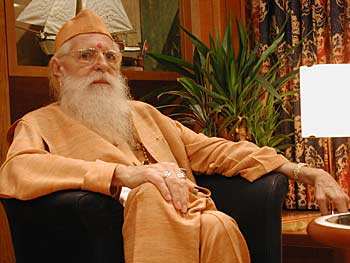
"You can't work at correcting something. You either do it or you don't do it. You don't work at not falling off a cliff, a big precipice that drops off a hundred feet. You just don't step forward; that's what you don't do! When you come to the point where you hear about the Self, and you get interested in the Self, you're at a point where you can break the cycle of certain karmas through sadhana. You're either going to do it or you're going to think, "Oh, that's kind of silly, you know. It's really nice to listen to Gurudeva, but to actually take these teachings seriously and make changes in my life, well�ho hum. That kind of attitude, that kind of ho-hum, lazy attitude, also results in making new karmas, because others look at you as an example and take up your example. It's living a double life that I am talking about. It depends on the strength of the person's soul whether he actually makes some definite changes in his character or not."
Gurudeva
Our Beloved and Revered Satguru Sivaya Subramuniyaswami
Attained Maha Samadhi on November 12th, 2001
Click to read for Details.
We are pleased to announce the web release of Satguru Sivaya Subramuniyaswami's monumental work on Hindu culture and lifestyle:
Living with Siva.
Click here for the entire text and artwork, now on-line!
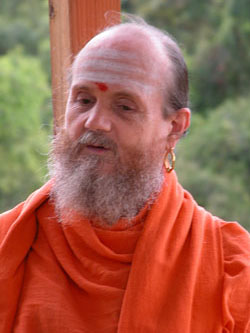
Bodhinatha departed this morning for his 19-day journey. The first stop will be San Francisco, California. While Gurudeva traveled all over the world and gave many discourses to huge crowds to countries far and wide, he rarely spoke to the general Hindu public in California during his later years. Thus Bodhinatha's Saturday evening discourse at the Ohlone College in Fremont is a "first time in this decade" speech from our lineage in the area where Gurudeva started his mission in the USA over 50 years ago.
Bodhinatha's Sun One Video. Most Recent update: July 30, 2003.
Bodhinatha speaks on Japa, Mantra Repetition, niyama # 9, elucidating the many dimensions of the sacred science of mantrams, chanting a holy syllable, word or sentence again and again.Japa may be done silently or aloud. Sometimes it is best to begin aloud, so the mind is more focused, then slowly let it become internalized as concentration improves. Often japa is done right after attending a puja. Japa is not used to acquire worldly things. Instead, prayers are used for that. People who anger should not practice japa.
The simplest japa is A-U-M. This is the primary sound of the universe. Initiation is important before starting the practice of japa yoga. Once initiated it is essential to continue the practice, to strive consistently and to chant as instructed by the guru.
14 minutes, 2 secondsNo Audio Today
|
Be surprised! Take this opportunity for an adventure. Close your eyes and click to get a message picked at random from the vast audio archives of our Satgurus' discourses |
And click here for an Index to All Past CyberTalks.
|
 |
|
|
|
Live Web Cam Pix! |
 |
||||
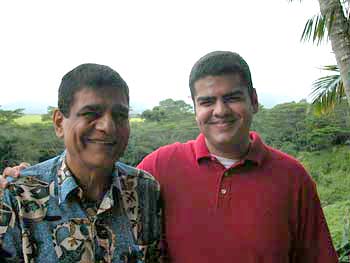
This is the joyful Ram Arora and his son Amit. Ram is a long time Hawaii resident living in Honolulu with his successful restaurant, India House. Don't miss it if you are passing through town. Ram has been very helpful to the monastery all through the years, acting as an "agent" for us in Oahu, which is the main port for the whole state. For example, he offered to help out our returning silpi, Chinnu who was here for two years before, and will be arriving early next month. Amit... just got back from London School of Economics, and is planning to go to a UCLA on the mainland soon.
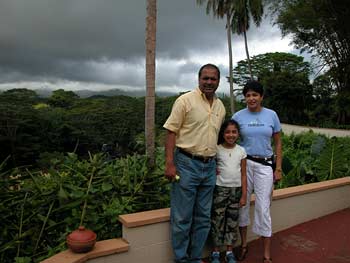
This is Avinash Argadhi, wife Sudhira and daughter Sonali from Florida. On vacation in Hawaii, they serendipidously found out about the temple while traveling around Kauai.
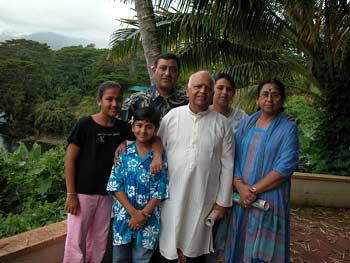
Mr. and Mrs. Sukumar Ramanan from Irvine California were also touring the state with their daughter Priyanka and son Rohan and Mrs. Ramanan's parents, the Raghavan's, from Bangalore.
 The Remarkable Vision |
Iraivan Temple Progress Update |
Join this historic undertaking. Please contribute generously. Sponsor a stone today! |
| Order Rudraksha Malas from Siva's sacred Hawaiian groves; and also single rudraksha beads ready to put on a chain around your neck. Great for Gifts! All proceeds go to the building fund. | ||
|
Current Overview  |
||
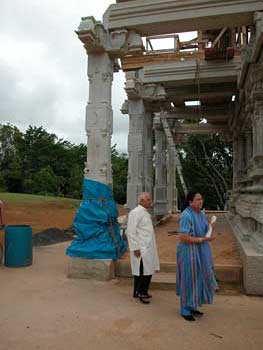
The elder Raghvans from Bangalore simply could not believe their eyes that such a place as Kauai Aadheenam and the temple would exist here on a remote island in Hawaii.
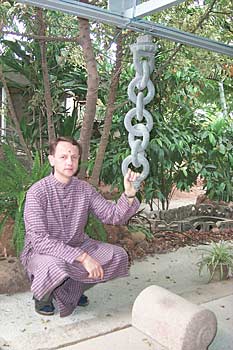
Here is a retrospective photo of Chandra Shekaran from the Ukraine at the Bangalore work site, holding one of the stone link chains that were carved from a single stone.
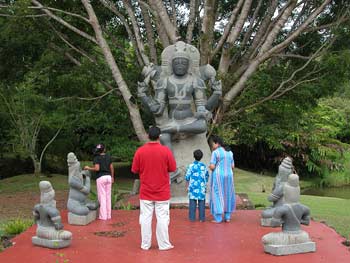
Amit Arora, Priyanka and Rohan and their grandmother stand in wonderment before the giant image of Dakshinamurthi.
| FULL INDEX OF 650+ CYBERTALKS
 |
|
Study Gurudeva's teachings.
|
transcription begins
Date: June_11_2003
Title: Yama #7 - Daya, Compassion
Category: Yamas and Niyamas
Duration: 10 min., 30 seconds
Date Given: April 24, 2003
Given by: Bodhinatha
Good Morning, everyone. I would like to welcome our guests. It is a pleasure to have you with us this morning.
Continuing on a series of the Yamas and Niyamas, Hinduism's Code of Conduct, the twenty principles - ten restraints and ten observances. Today's talk is on restraint, Yama #7 - Compassion, Daya, conquering callous, cruel and insensitive feelings toward all beings.
Gurudeva begins his 'Living with Siva' lesson on compassion with a most inspired Upadesha on this topic.
"Sometimes it is kind to be cruel, and at other times it is cruel to be kind. This statement has come forward from religion to religion, generation to generation. Compassion tempers all decisions, gives clemency, absolution, forgiveness as a boon even for the most heinous misdeeds. This is a quality built on steadfastness. Daya comes from deep sadhana, prolonged santosha, contentment, scriptural study and listening to the wise. It is the outgrowth of the unfolded soul, the maturing of higher consciousness. A compassionate person transcends even forgiveness by caring for the suffering of the person he has forgiven. The compassionate person is like a God. He is the boon-giver. Boons, which are gifts from the Gods, come unexpectedly, unasked for. And so it is with the grace of a compassionate person."
The Tirukural devotes Chapter 25 to 'Compassion' and in its verse 244, stresses its centrality of pursuing dharma.
"Practicing charity without compassion is as inconceivable as realizing God without clarity of mind."
The Kural chapter says that , "Compassion is a man's greatest wealth, protects one from misfortune and misery and leads to liberation."
Daya, compassion, is focusing on overcoming the instinctive tendencies to be totally self-centered and unaware of the feelings of others. We walk past beggars in India and have no clue as to their misery. We visit a home for the elderly and have no sense of the loneliness the residents there experience. This is definitely asking more of us than making sure our actions towards others are not harmful in deeds, words or thoughts. It is focusing on our inner feelings toward others, something we may have not thought much about.
Compassion is defined as conquering callous, cruel and insensitive feelings toward all beings. A compassionate person would tell a plant verbally if he was going to pick from it, intuiting that the plant has feelings of its own. A compassionate person would seek to keep pests away rather than killing them. A callous person would tear the plant up by it roots. A cruel person would, as a child, pull one wing off a fly and, unless corrected, mature this cruelty on through life until he maimed a fellow human being. Compassion is just the opposite to all this.
One cannot command compassion. Before compassion comes love. Compassion is the outgrowth of love. Love is the outgrowth of understanding and understanding is the outgrowth of reason. One must have sufficient memory to remember the various points of reason and enough willpower to follow them through to be able to psychically look into the core of existence to gain the reverence for all life, all living organisms, animate or inanimate. Compassion is a very advanced spiritual quality. When you see it exhibited in someone, you know he is very advanced spiritually, probably an old soul. It really cannot be taught. Daya goes with ananda. Compassion and bliss are a one big package.
"What is the difference between ahimsa and daya, non-violence and compassion?", one might ask. There is a distinct difference. Not harming others by thought, word or deed is a cardinal law of Hinduism and cannot be avoided, discarded, ignored or replaced by the more subtle concept of compassion. Ahimsa, among the yamas and niyamas, could be considered the only explicit commandment Hinduism gives us. Compassion comes from the heart, comes spontaneously. It is the total flow of spiritual, material, intellectual giving, coming unbidden to the receiver.
The first stage in the development of compassion is understanding and having sympathy for the suffering and misfortune of another. This eventually leads to the second stage in the development of compassion, feeling a strong desire to help someone. The person experiencing compassion is often turned around emotionally and mentally as he is giving the clemency this boon of absolution, despite his own instinctive or intellectual inclinations. This is a spiritual outpouring through a person. Rishi Tirumular used the word arul for this yama. Arul means grace. Tirukural also uses arul for compassion.
How do compassion and tolerance relate? To be tolerant with people we need to be able to accept them as they are. Not as we want them to be, but simply as they are. If our feelings toward them are compassionate, we better understand and sympathize with the difficulties they face and are therefore readily able to accept them as they are.
So far we have mentioned the first two stages in the maturing of compassion. The first, becoming aware of another's sorrow or misfortune. The second stage, a sense of wanting to help. This naturally leads to the third stage in the development of compassion, which is to respond to the situation with a kindly act. We meet some beggars in India and give them money to help their plight. We visit elderly relatives in the hospital and give them some of our time by talking with them at length. An uncle's wife is in the hospital and we arrange to cook and bring some meals to help alleviate his burden. This is indeed a mature state of compassion, as our sympathy and understanding of the other's misfortune has lead us to improve the situation with a kindly action.
Tirukural praises those who give in this way in many of its verses. Here is Verse 214.
"He who understands the duty of giving, truly lives. All others shall be counted among the dead."
There is a special category of people with whom compassion can be quite challenging. It is those who have wronged us, those who are on our list of enemies. At best we simply ignore them, at worst we would be really happy if a serious misfortune befell them. If misfortune does happen to them, at best we are unconcerned and at worst we are quite happy. In either case, this is not fulfilling the ideal of compassion. We need to resolve these kinds of interpersonal entanglements for maximum spiritual progress. If they apologize and show true remorse we need to forgive them and remove them from our list of enemies. Wish them well in life and feel compassion for them, as we do for others.
One simple way to increase our compassion for people is to take care of animals. This is particularly helpful in teaching compassion to children. We learn to understand the needs of the animal and how to take care of it without unnecessarily disturbing or hurting it. Learning to be kind to pets as a child helps us to be kind to people as an adult.
With a developed sense of compassion, the presence of abuse and other cruelties in the family are unacceptable to us. This is because we deeply feel the suffering that the other family member is enduring and realize that it can and should be avoided. Opposing such family abuse is an excellent way to cultivate compassion.
In conclusion, practice compassion by conquering callous, cruel and insensitive feelings toward all beings. See God everywhere. Be kind to people, animals, plants and the Earth itself. Forgive those who apologize and show true remorse. Foster sympathy for others' needs and suffering. Honor and assist those who are weak and impoverished, aged or in pain. Oppose family abuse and other cruelties.
Aum Namah Sivaya.
transcription ends
|
MORE UPLIFTING THINGS |
2004 Indian Odyssey
Join Satguru Bodhinatha Veylanswami on an 18 day Innersearch to South India, from Jan 19 to Feb 5, as we pilgrimage to ancient monasteries, magnificent 1,000 plus year old sacred temples and meet with India's holy men in a life-transforming adventure. Click on the above link for more details. |
|

|
Check our children and youth section for new items for the young and young at heart! | |
|
1. SIGN OUR GUESTBOOK and receive a FREE GIFT |
||
| 2. Newest Book: LIVING WITH SIVA | ||
|
3. Visiting KAUAI'S HINDU MONASTERY |
||
|
4. Contribute to THANK YOU, GURUDEVA FUND |
||